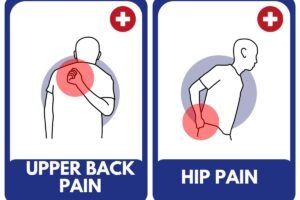Pilates for Back Pain Relief: Strengthen Your Core, Ease Your Discomfort
Back pain is a prevalent issue that affects millions of people worldwide, hindering daily activities and diminishing overall quality of life. While there are numerous methods for managing back pain, Pilates has emerged as a highly effective exercise regimen for alleviating discomfort and promoting spinal health. Let’s delve into how Pilates can help provide relief from back pain and improve overall well-being.
I. Introduction to Pilates
Pilates, developed by Joseph Pilates in the early 20th century, is a holistic exercise system designed to improve strength, flexibility, and overall body awareness. It focuses on controlled movements, breath control, and core engagement to enhance physical and mental well-being. The benefits of Pilates extend beyond physical fitness, encompassing improved posture, stress reduction, and enhanced mind-body connection.
II. Understanding Back Pain
Back pain can arise from various factors, including poor posture, muscle imbalances, sedentary lifestyle, injury, or underlying medical conditions. The lower back, or lumbar region, is particularly prone to discomfort due to its role in supporting the upper body and facilitating movement. Chronic conditions like sciatica, herniated discs, or spinal stenosis can exacerbate back pain and limit mobility.
III. How Pilates Helps Alleviate Back Pain
A. Core Strengthening
Pilates places a strong emphasis on core strengthening, targeting the deep abdominal muscles, obliques, and back extensors. By developing a strong and stable core, Pilates helps support the spine, improve posture, and alleviate strain on the lower back muscles.
B. Improved Flexibility and Mobility
Pilates incorporates dynamic stretching and controlled movements to improve flexibility and range of motion in the spine and surrounding muscles. Increased flexibility reduces stiffness and tension in the back, promoting ease of movement and reducing the risk of injury.
C. Postural Alignment
Pilates exercises focus on proper alignment of the spine, pelvis, and shoulders, helping to correct postural imbalances and alleviate stress on the back muscles. Improved posture reduces the risk of developing chronic back pain and enhances overall body alignment.

IV. Key Pilates Exercises for Back Pain Relief
A. The Hundred
The Hundred is a quintessential Pilates exercise that engages the core muscles while promoting deep breathing and circulation. By lying on your back and pumping your arms up and down, you activate the abdominal muscles and enhance core stability.
B. Pelvic Curl
The Pelvic Curl exercise strengthens the back extensors and mobilizes the spine. By lifting the hips off the mat and articulating through the spine, you promote flexibility and relieve tension in the lower back muscles.
C. Spine Twist
The Spine Twist exercise improves spinal rotation and flexibility, targeting the obliques and deep abdominal muscles. By rotating the torso while seated, you release tension in the spine and enhance mobility in the thoracic region.
D. Swimming
The Swimming exercise strengthens the entire back and promotes extension. By lying on your stomach and fluttering your arms and legs, you engage the back extensors and enhance muscular endurance in the posterior chain.
V. Incorporating Pilates into Your Routine
To experience the benefits of Pilates for back pain relief, consider incorporating Pilates exercises into your regular fitness routine. Aim to practice Pilates 2-3 times per week, focusing on proper form and alignment during each session. If you’re new to Pilates or experiencing severe back pain, consult with a certified Pilates instructor or healthcare professional for personalized guidance and modifications.
VI. Conclusion
In conclusion, Pilates offers a holistic approach to alleviating back pain and promoting spinal health. By strengthening the core, improving flexibility, and enhancing postural alignment, Pilates empowers individuals to manage discomfort and enjoy a more active and pain-free lifestyle. Whether you’re seeking relief from chronic back pain or looking to prevent future issues, Pilates can be a valuable addition to your wellness routine.
VII. FAQs About Pilates for Back Pain Relief
- Is Pilates suitable for all ages and fitness levels?
- Yes, Pilates can be adapted to accommodate individuals of varying ages and fitness levels. Beginners should start with introductory classes or private sessions to learn proper technique and alignment.
- How soon can I expect to experience relief from back pain with Pilates?
- The timeline for experiencing relief from back pain may vary depending on individual factors such as the severity of the condition, consistency of practice, and adherence to proper form. Many people report noticeable improvements within a few weeks of consistent Pilates practice.
- Can Pilates exacerbate existing back issues?
- When practiced correctly and under the guidance of a qualified instructor, Pilates is generally safe and beneficial for individuals with back pain. However, it’s essential to communicate any existing back issues or concerns with your instructor to ensure appropriate modifications are made.
- How does Pilates compare to other forms of exercise for back pain relief?
- Pilates offers a unique combination of core strengthening, flexibility training, and postural alignment, making it particularly effective for alleviating back pain. While other forms of exercise such as yoga or strength training may also provide benefits, Pilates provides targeted exercises specifically designed to address back pain and improve spinal health.
- Can I practice Pilates at home, or do I need to attend a studio?
- While attending Pilates classes at a studio with a certified instructor can offer valuable guidance and support, many Pilates exercises can be performed at home with minimal equipment. There are numerous online resources, videos, and apps available to help you establish a home Pilates practice tailored to your needs and preferences.



